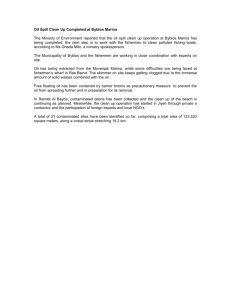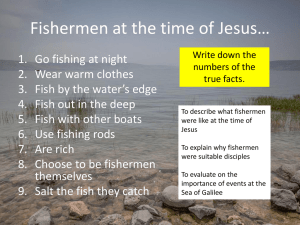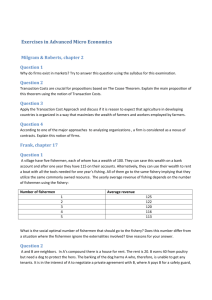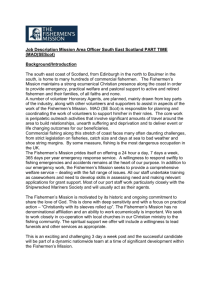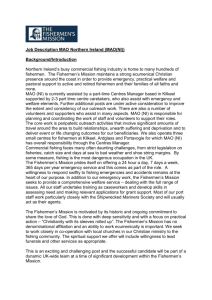Local Wisdom of the Fishermen’s Language and Livelihood Traditions
advertisement
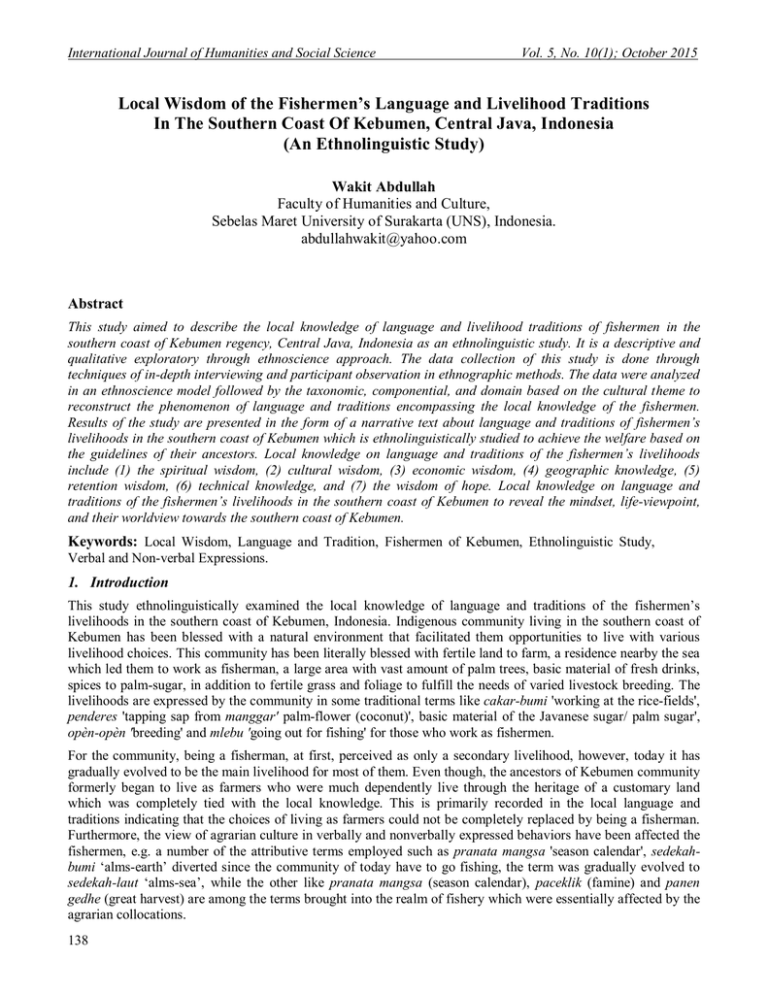
International Journal of Humanities and Social Science Vol. 5, No. 10(1); October 2015 Local Wisdom of the Fishermen’s Language and Livelihood Traditions In The Southern Coast Of Kebumen, Central Java, Indonesia (An Ethnolinguistic Study) Wakit Abdullah Faculty of Humanities and Culture, Sebelas Maret University of Surakarta (UNS), Indonesia. abdullahwakit@yahoo.com Abstract This study aimed to describe the local knowledge of language and livelihood traditions of fishermen in the southern coast of Kebumen regency, Central Java, Indonesia as an ethnolinguistic study. It is a descriptive and qualitative exploratory through ethnoscience approach. The data collection of this study is done through techniques of in-depth interviewing and participant observation in ethnographic methods. The data were analyzed in an ethnoscience model followed by the taxonomic, componential, and domain based on the cultural theme to reconstruct the phenomenon of language and traditions encompassing the local knowledge of the fishermen. Results of the study are presented in the form of a narrative text about language and traditions of fishermen’s livelihoods in the southern coast of Kebumen which is ethnolinguistically studied to achieve the welfare based on the guidelines of their ancestors. Local knowledge on language and traditions of the fishermen’s livelihoods include (1) the spiritual wisdom, (2) cultural wisdom, (3) economic wisdom, (4) geographic knowledge, (5) retention wisdom, (6) technical knowledge, and (7) the wisdom of hope. Local knowledge on language and traditions of the fishermen’s livelihoods in the southern coast of Kebumen to reveal the mindset, life-viewpoint, and their worldview towards the southern coast of Kebumen. Keywords: Local Wisdom, Language and Tradition, Fishermen of Kebumen, Ethnolinguistic Study, Verbal and Non-verbal Expressions. 1. Introduction This study ethnolinguistically examined the local knowledge of language and traditions of the fishermen’s livelihoods in the southern coast of Kebumen, Indonesia. Indigenous community living in the southern coast of Kebumen has been blessed with a natural environment that facilitated them opportunities to live with various livelihood choices. This community has been literally blessed with fertile land to farm, a residence nearby the sea which led them to work as fisherman, a large area with vast amount of palm trees, basic material of fresh drinks, spices to palm-sugar, in addition to fertile grass and foliage to fulfill the needs of varied livestock breeding. The livelihoods are expressed by the community in some traditional terms like cakar-bumi 'working at the rice-fields', penderes 'tapping sap from manggar' palm-flower (coconut)', basic material of the Javanese sugar/ palm sugar', opèn-opèn 'breeding' and mlebu 'going out for fishing' for those who work as fishermen. For the community, being a fisherman, at first, perceived as only a secondary livelihood, however, today it has gradually evolved to be the main livelihood for most of them. Even though, the ancestors of Kebumen community formerly began to live as farmers who were much dependently live through the heritage of a customary land which was completely tied with the local knowledge. This is primarily recorded in the local language and traditions indicating that the choices of living as farmers could not be completely replaced by being a fisherman. Furthermore, the view of agrarian culture in verbally and nonverbally expressed behaviors have been affected the fishermen, e.g. a number of the attributive terms employed such as pranata mangsa 'season calendar', sedekahbumi ‘alms-earth’ diverted since the community of today have to go fishing, the term was gradually evolved to sedekah-laut ‘alms-sea’, while the other like pranata mangsa (season calendar), paceklik (famine) and panen gedhe (great harvest) are among the terms brought into the realm of fishery which were essentially affected by the agrarian collocations. 138 ISSN 2220-8488 (Print), 2221-0989 (Online) ©Center for Promoting Ideas, USA www.ijhssnet.com Results of the previous studies on language and traditions in Kebumen regency, for instance, Kajian Geografi Dialek Bahasa Jawa Tengah bagian barat ‘the Study on the Geographical Dialect in Western Part of the Central Java Language’, a work by Nothofer (1989); Kajian Dialek Kebumen ‘Study on the Dialect of Kebumen’ (Sudiro, 1986); Kajian Bahasa Jawa Kebumen ‘Study on the Javanese Language of Kebumen’ (Priyadi, 2005); Kajian Sosiodialek Kebumen ‘Study on the Socio-dialect of Kebumen’ (Pujiyatno, 2007); and Kajian Sosiodialektologi Bahasa Jawa di Eks Karesiden Kedu ’Study on the Socio-dialectology of Javanese language of Ex-residency Kedu’ (Eka, 2009); Wakit (2009) has carried out research in the village of Karangrejo, Tegalsari, Ngampelsari, Munggu, and Karanggadung in the Petanahan districts, Kebumen regency. Therefore, this issue has never been studied by the previous researchers. In addition, studies on fisheries tradition have been carried out by Mubyarto (1984) who studied Nelayan dan Kemiskinan ‘Fishermen and Poverty’; Kepas (1987) discussed Pengelolaan dan Pola Perubahan Kawasan Pantai Utara Jawa: Studi Kasus Penelitian Agronomi ‘Management and Pattern Changes in the Northern Java Coast Area: A Case Study of Agronomic Research’; Sumarsono, et al. (1995) studied Peranan Wanita Nelayan dalam Kehidupan Keluarga di Tegal Jawa Tengah ‘the role of Women in the Family Life Fishing in Tegal, Central Java’; Herawati (1995) studied Sistem Teknologi Masyarakat Nelayan di Pekalongan ‘Technological System of the Fishermen Society in Pekalongan’; Wijaya (2003) wrote Pemberdayaan Kawasan Berbasis Nelayan the Development of Fishermen Based Areas; Wijaya (2003) wrote Nelayan Melaut Tanpa Jaminan the Hopeless Fishermen; Wijaya (2003) discussed Hasil Tangkapan Ikan Merosot Nelayan Terjerat Hutang ‘the Caught fish Decline Fishermen unable to pay the Debt’; Wijaya (2004) wrote the Plight of fishermen; Arba (2003) wrote Potensi Laut dan Masa Depan ‘Potential and Future of Sea’; Dahuri (2004) wrote Nelayan Jawa Tengah di Relokasi Akibat Overfishing ‘Fishermen of the Central Java get Relocated due to the Overfishing Consequences; Sumintarsih, et al. (2005) examined Nelayan di Madura Jawa Timur ‘Fishermen in Madura, East Java’; Suyami et al. (2005) examined Nelayan di Jepara Jawa Tengah ‘Fishermen in Jepara, Central Java’; Syarifuddin (2008) studied Mantra Nelayan Bajo ‘the Magic Words of Bajo Fishermen’; Fernandez (2009) studied Kategori dan Ekspresi Linguistik dalam Bahasa Jawa sebagai Cermin Kearifan Lokal Penuturnya ‘Category and Linguistic Expressions in the Javanese language as a reflection of the speakers’ Local Wisdom’: Kajian Etnolinguistik pada Masyarakat Petani dan Nelayan ‘The Ethnolinguistic study on Farmers and Fishermen Community’. Therefore, this study conducted to explain the local knowledge of fishermen as were reflected in the verbal and nonverbal expressions, the way they utilize the natural environment at the southern coast of Kebumen from the perspective of ethnolinguistic study. As far as it concerned there has not yet been researcher from previous scientific papers, with a sample of village in districts such as Petanahan, Klirong, and Ayah in Kebumen regency. This study took the location in Kebumen based on an assumption that this area includes an area that has a prototype of farmers (and fishermen) of native Javanese, formerly informed in the previous studies (Nothofer, 1989). Socio culturally related to the view of fishing communities, as summarized in the verbal expression saben nelayan mesthi petani, nanging saben petani durung mesthi nelayan 'every fisherman would also farmers, but a farmer may not necessarily a fisherman'. It is verbally expressed in the expression saben penderes mesthi petani, nanging saben petani durung mesthi penderes ' every sap-tapper must be a farmer, but every farmer may not necessarily a sap-tapper’. This verbal expression indicated that the community’s main livelihood was formerly farmers. Therefore, the process of transformation and diversification of livelihoods as a solution to deal with weather anomalies and demographic growth, then the option has to be taken for it is also very much loaded with the local wisdom to achieve community’s prosperity. This study objectively examined the local knowledge of fishermen-farmers community in the southern coast of Kebumen reflected in the verbal and nonverbal expressions in using the natural environment from perspective of the ethnolinguistic study to uncover community’s viewpoints about life (worldviews). Local wisdom is understood as "a device" of knowledge and practices that can be used to resolve to encountering problems in a good and right way (Ahimsa, 2007: 17). Further, Natasuwan (2000a, 2000b; also Na Talang, 2001 in Komothip), stated that “local wisdom as knowledge based on the experiences of people handed down over the generations, sometimes by those who maybe seen as village philosophers. This knowledge is used as a guideline for people’s daily activities connected with their families, their neighbors, and other people in the village and with surroundings”. ’Local wisdom is a knowledge based on the the community’s experiences that pass into generation to generation that can also be claimed as village philosophy’. This knowledge is used as ’guidance’ to everyday activities in making relationship with family, neighbors, and other society living soround. 139 International Journal of Humanities and Social Science Vol. 5, No. 10(1); October 2015 The ethnolinguistic (Anthropological linguistics) is a branch of linguistics which concerned with the position of language in a wider social and cultural contexts to promote and maintain cultural practices and social structures (Foley, 1997: 3). 2. Research Methods This study employed a descriptive-qualitative method using ethnographic method of the ethnoscience, ‘The New Ethnography or most commonly called the Cognitive Anthropology’ (Spradley, 1997: 19). In detail, the new ethnographic method (ethnoscience) according to Spradley (1997: 57) involves 12 phases of a gradually-step forward groove study (Developmental Research Process)1. To adjust the purposes of this study, the verbal and nonverbal data were analyzed by using the ethnographic research methods, particularly with the analytical models of ethnoscience (for example, employing the taxonomic analysis, componential analysis, and domain analysis) further step to relevantly obtain the analysis based on the cultural themes. Furthermore, certain data were analyzed through the linguistic research methods (Subroto, 1992; Sudaryanto, 1993). The primary data were obtained from (1) oral data in the form of folklore, rituals, mantras (magic word), prayers within the traditions of fishermen-farmers; (2) important information obtained from the selected informants; (3) practical data, covering the practices before, during and after mlebu 'sailing' to catch fish in the ocean. The secondary data, were in the forms of (1) records of the Javanese community’s language of lexicons prior to the work fields of fisheries, farming and tap. The primary data sources include (1) folklore, fairy tales, the community’s fixed daily local speech, and the like, (2) sources (research person)2 (3) cultural events (fishing activity, farmers’ ritual prayers and activities, fishermen, farmers, sap-tappers). Secondary data sources /written sources include (1) important notes, (2) articles, (3) books, (4) magazines, (5) newspapers, (6) research reports, (7) documents, and (8) other important archives. The data collection technique employed participant observation. It is the observation technique preceded with the establishment on participation and conducting the interviews to the selected informants, in addition to taking ethnographic notes, providing descriptive, structural, and contrastive questions (Spradley, 1997: 87, 99, 157, 201). The descriptive, structural, and contrastive questions are, therefore, accompanied by a number of techniques such as the technique of scrutinization, technique of conversation, technique of taking notes, and technique of recording (Subroto, 1992; Sudaryanto, 1993), additionally all of them completed with the informational identity of the sources; who, when, what, where they are fully and clearly archived to facilitate data analysis models of ethnoscience analysis (the taxonomic, componential, domain analyses). Then this study conducted interviews to the selected informants through in-depth interviewing technique. This is done to prepare the data at the time of analyzing the local knowledge using the ethnoscience model, particularly in accordance with the grooves of taxonomic, componential, and domain analyses (Spradley, 1997), these steps are done to come to further analysis which is to find the cultural themes. This study technically done with recording technique (using digital cameras, tape-recorder); note-taking technique for cultural products in the form of various types of lingual units; technique of scrutinizing to obtain data in the form of verbal and nonverbal behaviors, rituals; and the technique of conversation to ask about things which have not been clearly obtained on the research data with all the existing cultural significances. The validity of the data is done through the technique of triangulation; key informant review and member check (Sutopo, 2006: 92) such as (a) triangulation of the data, (b) triangulation of the researcher (investigator triangulation), (c) methodological triangulation, and (d) theoretical triangulation. Furthermore, the data were analyzed with the method of entholinguistic study by using ethnographic research methods, especially ethnoscience analysis models (Spradley, 1997: 120, 139, 175, 229). In addition, the analysis technique empirically employed methods of reconstruction toward the phenomenon reflected from the expression of verbal and nonverbal behaviors of the fishermen in using natural environment at the southern coast of Kebumen to comprehensively formulate the fishermen’s actualities of the local wisdoms. 1 The developmental research process involves; (1) establishing the informants, (2) interviewing (the informants) by providing them questions) (3) making ethnographic records, (4) asking descriptive questions, (5) conducting analysis of ethnographic interviews, (6) making domain analysis, (7) providing structural questions, (8) making taxonomic analysis, (9) asking contrastive questions, (10) analyzing data based on the components of meaning, (11) finding the cultural themes, (12) writing an ethnographic study. 2 Selected informant is a minimum requirement of five given criterias; (1) the full enculturation, (2) direct involvement, (3) the unknown cultural atmosphere, (4) adequate time, and (5) a non-analytical (Spradley, 1997: 61). 140 ISSN 2220-8488 (Print), 2221-0989 (Online) ©Center for Promoting Ideas, USA www.ijhssnet.com Results of the data analysis presentation employed formal methods, namely the formulation of the signs and symbols; and informal method which is the method of presenting results of the data analysis using common use words in order to be easily understood (Sudaryanto, 1993: 145). 3. Results And The Discussion 3.1 Geographic Location of Kebumen Regency The astronomical location of Kebumen Regency is between 7 ° - 8 ° Southern Latitude and 109 ° - 110 ° East Longitude. The regency is administratively divided into 22 sub-districts and 460 village areas / sub-villages. Geographically in the western area bordered with Cilacap and Banyumas, east to Purworejo, north of the Banjarnegara and Wonosobo regency, and to the southern areat bordered with the Indonesian Ocean / Indian Ocean (source Kebumen regency, 2009). 3.2 History of Kebumen Regency According to various existing sources as were obtained from the selected informants, the administrative and geographical region of today called Kebumen was formerly part of the territorial area of the Islamic Mataram3. The structure of the Islamic Mataram territory includes Negara Agung, Kutha Negara 'center of power', Manca Negara 'other areas', Wilayah Bang Wetan 'eastern region' and Wilayah Bang Kulon 'western region'. Kebumen, in this case, belonged to the Manca Negara Bang Kulon. Before emerging the name of Kebumen in the region of Manca Negara Bang Kulon there had already been an existing authoritative name Kademangan Panjer under the Islamic Mataram Panembahan Senopati4, approximately 1584 AD. Then it is told that the grandchildren of Panembahan Senopati Islamic Mataram named Ki Madusena, the child of a marriage relationship between K.R. Pembayun (firstborn Panembahan Senapati) with Ki Ageng Mangir Wanabaya VI (ruler of the free tax land in Mangir, Mataram), due to the political situation Ki Madusena was concealed in Karanglo. Ki Madusena in 1606 AD married Dewi Majati and has a child named Ki Bagus Badranala, then he became a student of Sunan Geseng at the Mount of Geyong. Shortly after that, Sultan Agung from Mataram Islam attacked Batavia (former name of Jakarta) (1628-1629) to strengthening the defenses to establish rice barns along the journey stripe of the soldiers, and Ki Bagus Badranala came to help them to collect foods from people of the village by way of purchasing (Kat Gien, 2004: 864-865). In 1627 the soldiers took benefit from the rice barns of Ki Bagus Badranala, and then that place was named Panjer. A messenger from Mataram named Ki Suwarna whose duty was to take care of logistics of the troops Mataram to Panjer, and finally Ki Suwarna was appointed as a regent in Panjer. While Ki Bagus Badranala as grandchildren of Panembahan Senapati who was characteristically assessed as a dubbed knight and was appointed to be a Mataram soldier that served a duty to be sent to Batavia to overseeing the logistics of Mataram forces. At the time of his ruling (1613-1645), during the 32-year reign of Sultan Agung Hanyakra Kusuma Kalifatullah Sayidin Panatagama could reach the golden era. He has set the basic ideology of the state called Sastra Gendhing5 beside it is realized in the form of Paugeran Nagari (Country of Laws), the structure of government and country region to be completely set, powerful army at the time, has a high state institution that served as an advisor to the king called parampara 'central resource', the members are of the royal house of the old-ages, scholars, and public figures. The King had always consulted the agency before taking any action. While there were also royal members of the clergy named Ki Bumidirja. When Sultan Agung passed away, Ki Bumidirja betrayed Amangkurat, the successor of Sultan Agung, because he cooperated with the VOC (Verenigde OostIndische Compagnie 'Dutch trading partner in Eastern Hindi'), then Ki Bumidirja retreated to the westward area of Panjer. Ki Bumidirja disguised as Kyai Bumi / Ki Bumi so that he was unknown to Amangkurat, and then the place where he lived was called Ka-bumi-an or Ke-bumi-an which then phonetically pronounced as Kebumen, and became the forerunner of Kebumen Regency in the present time. 3 Muslim kingdom that revived the old name of Mataram, Islamic Mataram, centered at Kerta. It is a kingdom that emerged after the fall of major pre-Islamic kingdom in Java called Majapahit in early sixteenth century (Keat Gien, 2004: 864) 4 Senopati was a title conferred by the kings of Demak and Pajang on prominent people in rural areas during the fifteen and sixteen centuries. In addition, the Senopati was a strong figure who attempted to extend his rule over all Java but was not acknowledged as a supreme sovereign by the coastal authorities (Keat Gien, 2004: 865). 5 Literature Gendhing contains the teachings about social philosophy (Damardjati Supadjar, 2001) 141 International Journal of Humanities and Social Science Vol. 5, No. 10(1); October 2015 3.3 Local Wisdom Reflecting from the Verbal and Nonverbal Expression of Fishermen in Using the Natural Environment in the Southern Coast of Kebumen. Local wisdom reflected from the verbal and nonverbal expressions both fishing and farming activities to use the natural environment in the southern coast of Kebumen as followed; 1) Spiritual wisdom, this wisdom reflected from the way the fishermen taking advantage of the natural environment to avoid being a subject of the occult disturbance, the action portrayed in the verbal expression mbekteni 'honoring', ngawekani 'being aware of the spirit presence' and the nonverbal expression by giving an offering to the magical figure Ratu Pantai Selatan ‘Queen of the southern coast’. If the interference is still troubling the community, they are recommended to use spells, prayers, or gaman ‘heirloom’ for the antidote. The community believes that along side of the southern coast of Kebumen is a place where the fishermen can make a living but the area is also very much known as a kingdom of a mystical beings 6. The spirit verbally expressed as Rara Kidul, a female figure who is expressed differently among several other places of Java Island. To neutralize these places from the spirit, the community took their attention to that unseen being by way of performing rituals like Sedekah laut ‘alms-sea’ sesaji-laut 'offerings-sea' and sedekah-bumi ‘offerings-earth' as the libation; in addition to reciting the magic words and prayers conducted at the land and sea, these are meant to obtain welfare, safety, peace of mind, a also a conduct to follow the testament of the ancestors. Sedekah laut ‘alms sea’ performed through media of various ubarampe 'devices of offering' in accordance with the testament and the Queen of Kidul7, for example kupat-lepet8' resides a deep cultural meaning. Kupat ‘a person who admits’ then lepat is the acronym of 'of being guilty’; with the rituals they apologize and ‘slamet 'hoping for a salvation'. The term lepet derived from the root word lepat 'being mistaken or wrong'. Other wisdoms like njabel 'picking up' paddy from the rice field, some were taken to create a doll that portraying figure of Dewi Sri 'the Goddess of Prosperity' and then stored in the rice barn with tawa leaves, watu ‘stone’, and kacang panjang ‘long-beans’. Tawa leaves intentionally were used to cool up or tawa 'cause it calm', Watu 'stone’ means ‘crate, strong’, and kacang dawa 'long-beans' cause lasting, dawa 'long' so that the harvests can be enough consumed until the next harvest season. 2) Cultural wisdom, this wisdom reflected from the way the fishermen preserving their ancestral traditions, the events were customarily held in every year, and performed as Sedekah laut ‘alms-sea’ or ‘offerings of the sea’ on Tuesday on the months of Kliwon Sura or Sapar (of the Javanese Calendar) to honor Ratu Kidul 'Queen of the Southernern Sea of Java' which is done to achieve the life salvation. Whereas, sedekah-bumi ‘alms-earth’ 'sesajibumi’/‘offerings of the earth' held in every year on Tuesday and on the months of Kliwon Sura or Sapar to honor mimang/dhanyang 'the gatekeepers of certain local places', those who are community who work as farmers to get a life safety. In the one hand, the fishermen believe to follow suggestion of the ancestral tradition to establish their own homes in specific direction to the southern side which is intentionally done to avoid ngingkuri 'turning backside against the Queen of the southern sea', unless it is believed that anyone of them could fall into ‘karma’ or kasedhak’, on the other hands, it is also perceived as an actualization of traditions taught by the elders. In addition, their culture reflected from the verbal expression saben nelayan mesthi petani, nanging saben petani durung mesthi nelayan 'every fisherman must be a farmer, but every farmer could not be a fisherman'. Similarly, this is also equally expressed in the verbal expression saben penderes mesthi petani, nanging saben petani durung mesthi penderes 'every sap-tapper must be a farmer; however, every farmer could not be a sap-tapper’. Both verbal expressions reside a pivotal meaning that the community’s main livelihood at first was farming. 3) Economic wisdom, this wisdom reflected from the way the community undergoing the transformation of the livelihoods beginning from farmers to fishermen, or vice versa. (a) In addition to planting pari-gaga in the rice field, people also take advantage of the barren sandy land to which they convert it into a productive land by way of sprinkling the land with lemon 'fertilizer' of tlepong 'cow dung' and cemendhil ‘goat dung' and make the soil well-balanced to plant gandhul kalifornia 'Californian papaya' tiris 'coconut seeds', and other types of vegetable. 6 Nasimin (54th year old), Darmuji (76th year old), Sarpin Muhtadi (58th year old), Misdam (43rd year old) of Kebumen, Central Java, Indonesia). 7 Rara Kidul materially may be varied in some places; it is a type of personifications of the female figure Nyai Rara Kidul, Queen Mother, Queen Mbok, Santajaya, Nyi Ronggeng, Dewi Sulastri, Queen Pembayun, Retna Suidha, Sulasih Goddess, and male personification of Ki Bandayuda, Ki Singayuda, Ki Bajul Putih, Ki Bagussetu). 8 Rice cooked in a packet of coconut leaves 142 ISSN 2220-8488 (Print), 2221-0989 (Online) ©Center for Promoting Ideas, USA www.ijhssnet.com (b) The community exert the existing potential nature of the surrounding land, on the mainland the activity called cakar bumi (literally means; the claw of earth) ‘cultivating’ for farmers, sap-tappers and ranchers, this activity involved people of both fields; fishermen 'fishing and catching fish from the hinterland' as well as fishermen mlebu 'going out to the sea for fishing in the middle of the ocean by a boat'. Their profile as people who get more chance to stay both in the land and the sea, because of that situation, all the livelihood options are undertaken as strategies to overcome the problem of livelihood due to the extreme weather anomalies, demographic growth and the call of local authorities. The verbal expression use, nyong ndi sing ana boga dioyik tebane asil ulih bena urip 'I (will) go to somewhere of pursuing materials to eat, a place where I can obtain something (so that I am able) to survive'9. (4) Geographical wisdom, this wisdom reflected from the way the community make use of the sandy land which is piled with fertilizer called lemon to poster humus and to plant or to avoid plants/trees being hit by abrasion. (a) To overcoming the soil abrasion so that the sea water will not erode the southern coast of Kebumen, it is highly recommended for the community to plant a tree like‘klaraside’, nyamplung fruit, tiris 'coconut seeds' (cikal), pandan, and various grasses like depleng, kemangian, pulutan, puyengan, and gajah grass. The principle is reflected from the verbal expression mbluju kebak ledhu, udan kanginan gampang growang 'sandy soil, (hit by) rain and winds can easily get eroded', it is necessary to laputan sabarang wit 'plant of various trees'10 by organizing the reforestation movement. (b) When the rice fields inundated by rob 'flood', the community start to strew the seeds of fresh water fish, among types of the fish are bawal, mujaer, nila, lele ‘catfish’, and udang ‘shrimp’. In this case, the financial capital collectively organized, thus the crops determined by the issued shares, this principle reflected from the verbal expression unggahmu pira udhunmu pira 'how much your stock, they are the benefits that you get'. How to harness rob disaster into a new blessing by pouring with various fish germs as fishermen wisdom in facing the natural environment. Principally, maintaining gisik 'the inundated rice fields 'flood' through kerigan 'community service/mutual assistance'11. They are not restless with how long rob 'the flood' progress goes on, for it is reflected from their verbal expression saya suwe iwak saya gedhe saya larang regane 'the longer flood stands, the bigger the fish and more expensive they are to be sold'. The community recognizes the longest rob stands about 3 months; the fish's age must be at harvest. This wisdom also includes the economic wisdom of fishermen to meet the family income in facing the extreme season. (c) Technical Wisdom, this wisdom reflected from the way how the fishermen at the southern coast of Kebumen identify technical problems in regard of the ocean wave. One of the prominent techniques is choosing the nets either to fit either with the big or the small fish, repairing the boats, learning how to control the ship in the middle of the sea in case the boats overwhelmed with a heavy weave. Because of their less technical experience of learning with other fishermen from Cilacap regency, who were known as the community that in advance involved in fishery tradition and thus have more experience being on the sea. (d) Wisdom of expectation, this wisdom reflected from the way the fishermen take serious concern of their lives at the southern coast of Kebumen, when the land is famine then the sea becomes a new hope for a living. When the living on the sea for fishing and on the land as farmers are not profitable, because of heavy waves and plant pests attacking the plants, another option that has to be taken is to menderes 'tapping sap from manggar ‘palm/coconut flower' and raising livestock become an alternative livelihood so that community’s income remains stable. 3.4 Socio Cultural Aspects Affecting the Farmers-Fishermen and the Fishermen- Farmers Spheres at the Southern Coast of Kebumen. The socio-cultural aspects which have affected the fishermen reside in the cultural meaning of the verbal and nonverbal expressions. Eg. cultural meaning of the ritual ceremony of tani-nelayan ‘farmers-fishermen’ to respect Dewaning Samudra 'the god of the sea' expressed as Ratu Kidul and tani-nelayan ‘fishermen-farmers’ to honor Dewi Sri ’the Goddess of Prosperity’ or mimang/dhanyang 'gatekeepers of certain place'. All proceeds is undertaken in order to keep the catch (fish) a lot, the plants could be protected from the pests within the growing season cycle to follow pranata mangsa' ‘astronomy, calculations of the seasons' as well as management of the 9 Nasimin (54th year old, Munggu, Petanahan, Kebumen, Central Java, Indonesia. Mr. Barjo (46th year old), Mr. Sarpin (58th year old), Kebumen, Central Java, Indonesia. 11 Mr. Dirun (46th year old, Munggu, Petanahan, Kebumen Central Java, Indonesia. 10 143 International Journal of Humanities and Social Science Vol. 5, No. 10(1); October 2015 community’s crops according to preliminary calculations. The actuality among others reflected in the cultural meanings of verbal expression of the spells performed by each individual of the community before going out for fishing, the expression is Dewaning bumi dewaning samudra, nunut mangan sapalilahe, nyong mung aweh bebana gula-klapa emoh jiwa-raga, slameta mangkat lan mulihe nyong rina lan wengine, slamet-slamet kersaning Allah means "The God of the Earth and The God of the sea, I sincerely intersect seeking for livelihood, I just want to give a change in the form of gula-klapa ‘palm sugar’, but I do not want to lose of body and soul, may I be safe in my departure and return as well as my every night and afternoon, may I be safe because of God'. The cultural meanings reside in the spells indicated that the community’s mindset and worldview reflect the belief on the existence of a gatekeeper in every land and sea, expressed as Dewaning Bumi ‘god of the earth and Dewaning Samudra ‘god of the Ocean, despite every possibility is under the destiny and the power of God, then the hopes for salvation ‘slamet-slamet kersaning Allah’ 'to be safe because of the God'. Philosophically, another kind of local wisdom found within the farmers community reflect the way these people maintain balance of the nature and spirituality to keep them in consciousness by giving a replace (to the spirit beings)‘aweh bebana gula kelapa 'to replace with the palm-sugar’, ‘but do not want to aweh jiwa-raga 'giving up body and soul'. This wisdom raises a cultural meaning, in which mathematically, that they realize that to go fishing to the ocean means to take "the owned property" of the gods of the ocean, then by asking the support of God of Earth whose name is so called, then the community give up gula-klapa ‘palm-sugar’ result from the cultivated land, with a hope that his/her soul and body not to be taken as a replacement for a safe. The spells recited at the time of catching the fish in the ocean, nyong jala sira ora lunga, nyong (a)doh sangka darat, mara sapalilah sira, nyong butuhaken sapira kancanira kabeh gak ana sing kari, dadi-dadi kabeh wis ngerti arep dadi siji kersaning Hyang Widi 'I'll net you (o…fish) do not go, I am far from land, move closer voluntarily, I need all your friends not to leave, so-so all already know will be gathered into one with the permission of God'. The cultural meaning reflected from the spell illustrate that the demand for the fishermen on the fish to keep up his hopes for everything that prevent fish caught beyond consciousness. In addition, it illustrates that the "fish" or “Dewaning samudra” has always been treated with "honor", as it mentioned with the word sira ‘you’ to refer to the fish. Semantically sira is a lexicon used to refer to the fish which also has an idiosyncratic meaning 12 as if the fish are treated like human beings, because the fishermen realize that their living dependence is very much on the caught fish. In addition to perform such spells, it is a reflection towards the belief in the god of the ocean that will protect them against the threat of Santajaya for the safety of fishermen’s safety life in making a living throughout the southern coast of Kebumen during the day and night. Verbal and nonverbal expressions of farmers-fishermen and fishermen-farmers have shown the process of transformation reflected from the local knowledge of fishermen, a traditional way that have been opted to achieve well-being, salvation, and thus shown their way of life, view of the world, mindset as a system of knowledge (cognitive system) practiced at the southern coast of Kebumen. Thus by that way the fishermen try to apply excellence in manners to behave with the ocean "bekti'' ‘to be respectful' and to be aware of the individual’s dependence relied on the sea, and on the land as farmers. While on the sea with all of the blessing of the fish variants, there is a thought to ask permission and salvation prayers, alms-sea 'offerings to the keepers of the sea' as part of a ritual ceremony to prevent the unexpected things happening while going fishing in the middle of the sea. 3.5 The Verbal and Nonverbal Expressions Reflecting from the Mindset, Worldview, and the View of the World of the Fishermen in Southern Coast of Kebumen. Through verbal and nonverbal expressions practiced by farmers-fishermen and fishermen-farmers communities at the southern coast of Kebumen, they are the reflections of the communities’ mindset, worldview on life and views of the world. Nonverbal expression (rituals, offerings equipment) have always followed by the verbal expressions (terms) and the meanings that can be scrutinized on the context of language and culture. E.g., wiwit 'planting' and when jabel 'harvesting' of paddy reflects the realm of farming. Farmers’ verbal spell expression wiwit 'planting' paddy, nyongn nandur Dewi Sri ana kene, mbabar pari sakethi sak palilahe Hyang Widhi, subur-subur dadi makmur 'I here would like to plant Dewi Sri, to sow a pinch of paddy with permission of the God, be fertile and fertile to become prosper'. The spell of jabel 'harvesting' paddy, the verbal expression is nyong mboyong Dewi Sri maring kadhatone dadi pari nguripi mbarkahi sabumi ‘I here would like to carry Dewi Sri into her palace, to be the rice that can live up the whole earth. 12 Idiosyncrasy is a meaning especially given which also reflects spiritually unique things (Echols dan Shadily, 1996: 310). 144 ISSN 2220-8488 (Print), 2221-0989 (Online) ©Center for Promoting Ideas, USA www.ijhssnet.com In the realm of fishermen, they have their own spell which is essentially the non-verbal spell following their activities during on the sea,‘dewaning bumi dewaning samudra, nunut mangan sapalilahe, nyong mung aweh bebana gula klapa emoh jiwa raga, slameta mangkat lan mulih nyong rina lan wengine slamet-slamet kersaning Allah’ means "the God of the Earth and the God of the sea, I sincerely beg for a living, I just want to give a replace in the form of palm sugar, but I do not want my soul (to be taken), may I be safe in my departure and the return as well as every night and afternoon, may the safe due to the God. The nonverbal expressions reflected from the ritualistic ceremonies, e.g., sedekah bumi (alms earth) and sedekah laut (alms sea) reflect the mindsets, attitudes towards life and worldview of the community. The offering equipments were prayed in thanksgiving/salvation ceremony to the God for the blessings of both the rice harvest and the caught fish. The offering equipments indicated to have four benefits; complete nonverbal expression with verbal expression of the offerings to the God, the ruler of the sea, the ruler of the land, and to each individual in the community. The rituals have been practiced and directed as an intention to maintain a balance, toward the equilibrium of both macrocosm and microcosm, horizontal and vertical, and as a religious society of Java who still have a sense of solidarity among each member, sharing, and mutual-assistance. In addition to reflecting the community’s patterns of thought, the spells performed by the fishermen-farmers community, e.g. for the farmers, at the time of sowing paddy seeds and for fishermen during going out for fishing on the sea, it is their belief that that they will reap more profits if only seeking for the God’s permission. It is a type of traditional views that have been well-maintained from generation to generations as a community that distinguished their realms of profession into tani-nelayan ‘farmers-fishermen’ nelayan-tani ‘fishermen- farmers’, this is also a reflection from the wisdom of making a living on the ocean environment and the land throughout the southern coast of Kebumen. 4. Conclusion Results of this study can be concluded that the local knowledge reflected from the way fishermen make use of the natural environment to make a living at the southern coast of Kebumen were done to obtain welfare. All the practices was done based on the instructions (inherited guidelines) given by the ancestors, a number of the practical ways reflect (1) the spiritual wisdom, (2) cultural wisdom, (3) economic wisdom, (4) geographic knowledge, (5) technical knowledge, and (6) the wisdom of fishermen’s expectations. Hence, the wisdom of fishing reflected from the verbal and nonverbal expressions showed the mindsets, viewpoints of life, and the community’s worldview toward living in the southern coast of Kebumen regency, that geographically very much influenced by the socio-cultural context of the Javanese language and culture at the southern coast of Kebumen from which the fishermen live in. Reference List Abdullah, Wakit & M.V, Hartini (2009). Language and Culture of Fishermen in the Southern Coast Java of Kebumen from the perspective of entholinguistic study. A Survey Result, on November-December 2009. Surakarta: Postgraduate Program of Universitas Sebelas Maret. Ahimsa, P., & Shri, H. (2007). Scientist of Culture and Revitalization towards the local wisdoms, theoretical challenge and methodology). Scientific speech at the 62nd anniversary of FIB UGM in Yogyakarta. Yogyakarta: Gadjah Mada University Press. Edi Subroto, D., et.al, (2003). Ethnolinguistic study towards Paribasan, Bebasa, Saloka, Pepindhan and Sanepa Javanese types of proverbs’. A research Report. Surakarta: Postgraduate Program of Universitas Sebelas Maret. Foley, W. A. (1997). Anthropological Linguistics an Introduction. University of Sydney: Blackwell Publishers. Keat Gin, Ooy. (2004). The Southeast Asia – A Historical Encyclopedia from Angkor Wat to East Timor. Santa Barbara, California: ABC-CLIO. Inc. Nothofer, B. (1989). Syncronic and Diacronic Study toward the Dialects of the Javanese Language in the West Java and the Western Central Java. A Paper. Pusat Studi Bahasa-bahasa Asia Tenggara-Pasifik. Yogyakarta: Faculty of Letter of Universitas Gadjah Mada, on Desember 8th 1990. Spradley, James P. (1997). The Ethnographic Interview. Translated by Misbah Zulfa Alizabeth entitled Metode Etnografi (Ethnographic Method)”, Yogyakarta: Tiara Wacana. Tim (2009). On the Establishment of the Anniversary of the Regional Government II Kebumen, Diktat, Kebumen: Regional Government II, Kebumen Regency. 145
